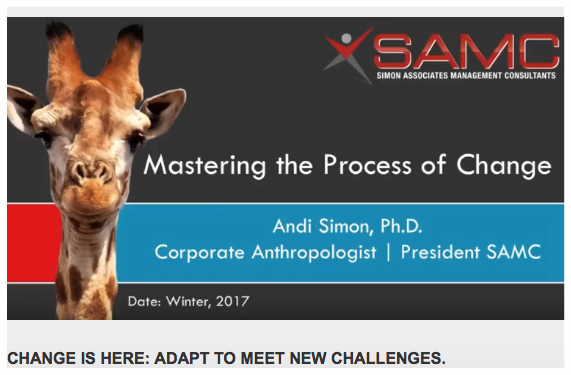Previously, we wrote about our work with CEOs at ITESM in Mexico. These were 50 very smart, successful business leaders who brought us in to help them find new markets and change their corporate cultures. The real challenge, they told us, was how to change their organizations. There are a number of ways to create a more innovative culture, embed change processes into those old, established ones, and provide more skill-development and confidence so your employees can embrace change. I thought I would share with you some of the things we discussed so you can build your own tool kit for taking the new and making it happen.
Today, in this Part 1 of the discussion, I want to talk about one approach that you might take—namely, to bring in the consultants and let them help you design, develop and implement the new “you.” Being management consultants, we often are brought in to do just that—become the chief strategists for an organization and help them go through the changes. Yet, we know that it is hard to build a new organization from the outside-in. It doesn’t always work well and I want to start this blog with an illustrative case to show you some of the pitfalls that you must anticipate if you are going to use consultants wisely.
This particular client situation was one where those “other” consultants did not achieve the desired results. As a case study, it serves to illustrate how to re-think the best use of outside resources. Use consultants. Let them help your organization develop and implement a change in direction. But make sure those consultants understand how to Engage, Educate and Manage Expectations—the key to the toolkit—among your own team.
You may want to get to the toolkit right away so you can start to try this aproach to take that new strategy and make it happen. Take a look at this webinar before you read further—or read on!
One Way To Go Forward: Let’s get the consultants to help us
First, you already know that you need to take a serious look at your organization, what it does and why growth has stalled. Even Starbucks is seriously reevaluating its 2017 performance in light of flattening U.S. sales volume in 2016. Stall points are common even among the top Fortune 500 companies. Over the past 50 years, 87% of these Fortune 500 companies have at one moment or another had their growth stall. So this is not personal. You might read Stall Points by to learn more about why companies stop growing.
How do you sustain your growth? One approach is to bring in consultants to lend some fresh perspective, experience and expertise to your process. Is this the best approach? Is it the right one for you?
Let me share a case study, and we can think through when and how to best use those outsiders to help transform the inside of your organization.
Stalled Company, New Strategy, No Execution
We were working with an old-line manufacturing company that brought in a big consulting firm to help them redesign their operations, reduce costs, create a new business strategy and develop a plan to implement it. The consultants were quite good. Their team of six talented people approached the organization systematically. After several weeks onsite, they came up with excellent recommendations.
The job we had was to communicate the initiative to the organization and help the outside consultants implement the changes. As the broker between idea development and implementation, we had to craft the story in such a way that it didn’t sound like a foreign entity had invaded the company to bring in new ideas.
Unfortunately, as seen from the inside of the company, the consultants were almost like invaders. They may have been experts in the development of organizational improvements and strategy redesign, but to the employees, they appeared to be foreigners who apparently didn’t know the important legacies for the business designed by the founder in the 1940s.
Neither did their implementation plan correctly recognize the roles that different people played in the operations of the organization. Since this was a fourth generation family firm, the complexity of relationships was profound. Instructing or directing one area to change had a serious ripple effect throughout the entire organization.
Three months after the consultants left, their plan and the changes were pretty much gone. A few stuck. Most were ignored quickly as soon as someone was not looking.
The use of consultants was a very expensive investment that could have had significant positive impact on the bottom line of the organization. Instead, it flopped. Not long after, so did the company. The sacred values, beliefs and behaviors of the family firm were so enduring that they undermined the changes and frustrated the leadership. The consultants disregarded those cultural traditions and in the process built a relationship that undermined the value they could have brought to the company.
The Problem with Changing People
Not all consulting initiatives fail upon implementation. I have had great clients for whom our recommendations remained on the shelves awaiting someone to make them happen. It is ok! But is it?
Managing change is challenging. You can read more in this HBR classic article: “The Hard Side of Change Management.” The literature and research are abundant on why change programs—whether they were downsizing, re-engineering or lean—don’t get the results that are intended or necessary. The interplay of the change agent and the culture of the organization come together to frustrate each other. If not handled well, they lead nowhere.
Add to this the fact that the brain hates to change and you have a lot of hurdles to jump over to move forward. This blog:
might help you better understand these battles over change.
What to do?
The challenges this client experienced is far too typical and reflects the nature of human resistance to change. What it did not reflect was what we know about how to build an organization that can take the new ideas and turn them into major transformations.
Essentially, you have to understand the way humans resist change and then capitalize on the power of three things: Engagement, Education and Expectation Management. It also reflects the important of Fair Process. What do these mean and why could they have made the manufacturing company reinvent itself effectively?
Stay tuned for my next blog where I will lay out for you what these mean. I worked with the CEOs in Mexico on how they could build organizations of people who embrace change and understand how to make new ideas and observations turn into innovations that stick.
In the meantime, take a look at this webinar where we review some of the core steps to take to change your organization—all or part of it—to adapt to changing times.
If you would like some time to discuss your change challenges, please send us a note or give us a call:
From Observation to Innovation,

Andi Simon, Ph.D.
Corporate Anthropologist | President
Simon Associates Management Consultants
Info@simonassociates.net
@simonandi




